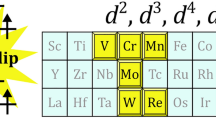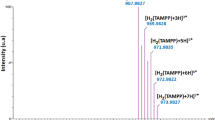Abstract
A group of novel 2-aryl imidazole derivatives were synthesized and characterized by NMR spectra, X-ray, mass and CHN analysis. An excited state intramolecular proton transfer (ESIPT) process in hydroxy imidazoles (dmip and dmtip) have been studied using emission spectroscopy and it was detected that the two distinct ground state rotamers of I and II are responsible for the normal and the tautomer emission respectively. In hydrocarbon solvent, the tautomer emission predominates over the normal emission for both dmip and dmtip. This reveal that rotamer II is responsible for the tautomer emission and it is stabler than rotamer I which causes the normal emission. In alcoholic solvent like ethanol, a dramatic enhancement of normal emission is observed which was due to increased solvation, the more polar rotamer I become stabler than rotamer II. In dioxane—water mixtures it is observed that the addition of water inhibits the ESIPT process due to the formation of the intermolecular hydrogen bonding involving water. DFT calculations on energy, dipole moment, charge distribution of the rotamers in the ground and excited states of the imidazole derivatives were performed and discussed. PES calculation indicates that the energy barrier for the interconversion of two rotamers is too high in the excited state than the ground state.










Similar content being viewed by others
References
Chou PT, Martinez ML, Clements JH (1993) Reversal of excitation behavior of proton-transfer vs. charge-transfer by dielectric perturbation of electronic manifolds. J Phys Chem 97:2618–2622
Gai F, Rich RL, Petrich JW (1994) Monophotonic ionization of 7-azaindole, indole, and their derivatives and the role of overlapping excited states. J Am Chem Soc 116:735
Das K, Sarkar N, Ghosh AK, Majumdar D, Nath DN, Bhattacharyya K (1994) Excited state intramolecular proton transfer in 2-(2′-hydroxyphenyl) benzimidazole and -benzoxazole: effect of rotamerism and hydrogen-bonding. J Phys Chem 98:9126
Roberts EL, Dey J, Warner IM (1997) Excited-state intramolecular proton transfer of 2-(2′-hydroxyphenyl)benzimidazole in cyclodextrins and binary solvent mixtures. J Phys Chem A 101:5296–5301
Agmon N (2005) Elementary steps in excited-state proton transfer. J Phys Chem A 109:13–35
Park S, Kwon OH, Lee YS, Jang DJ, Park SY (2007) Imidazole-based excited-state intramolecular proton-transfer (ESIPT) materials: observation of thermally activated delayed fluorescence (TDF). J Phys Chem A 111:9649–9653
Park S, Seo J, Kim SH, Park SY (2008) Tetraphenylimidazole-based excited-state intramolecular proton-transfer molecules for highly efficient blue electroluminescence. Adv Funct Mater 18:726–731
Qian Y, Li S, Zhang G, Wang Q, Wang S, Xu H, Li C, Li Y, Yang G (2007) Aggregation-induced emission enhancement of 2-(2′-Hydroxyphenyl)benzothiazole-based excited-state intramolecular proton-transfer compounds. J Phys Chem A 111:5861–5868
LeGourriérec D, Kharlanov VA, Brown RG, Rettig W (2000) Excited-state intramolecular proton transfer (ESIPT) in 2-(2′-hydroxyphenyl)-oxazole and –thiazole. J Photochem Photobiol, A Chem 130:101–111
Rodembusch FS, Campo LF, Stefani V, Rigacci A (2005) The first silica aerogels fluorescent by excited state intramolecular proton transfer mechanism (ESIPT). J Mater Chem 15:1537–1541
Campo LF, Rodembusch FS, Stefani V (2006) New fluorescent monomers and polymers displaying an intramolecular proton-transfer mechanism in the electronically excited state (ESIPT). IV. Synthesis of acryloylamide and diallylamino benzazole dyes and its copolymerization with MMA. J Appl Polym Sci 99:2109–2116
Rodembusch FS, Leusin FP, Campo LF, Stefani V (2007) Excited state intramolecular proton transfer in amino 2-(2′-hydroxyphenyl)benzazole derivatives: effects of the solvent and the amino group position. J Lumin 126:728–734
Wu Y, Peng X, Fan J, Gao S, Tian M, Zhao J, Sun S (2007) Fluorescence sensing of anions based on inhibition of excited-state intramolecular proton transfer. J Org Chem 72:62–66
De Prasad S, Ash S, Dalai S, Mishra A (2007) A DFT-based comparative study on the excited states intramolecular proton transfer in 1-hydroxy-2-naphthaldehyde and 2-hydroxy-3-naphthaldehyde. J Mol Struc, Theochem 807:33–41
Gostev FE, Kol’tsova LS, Petrukin AN, Titov AA, Shiyonok AI, Zaichenko NL, Marevtsev VS, Sarkisov OM (2003) Spectral luminescent properties and dynamics of intramolecular processes in 2, 4, 5-triarylimidazoles. J Photochem Photobiol, A Chem 156:15–22
Sastre R, Costela A (1995) Polymeric solid-state dye lasers. Adv Mater 7:198–207
Chou P, McMorrow D, Aartsma TJ, Kasha M (1984) The proton-transfer laser. Gain spectrum and amplification of spontaneous emission of 3-hydroxyflavone. J Phys Chem 88:4596–4599
Stueber GJ, Kieninger M, Schetter H, Busch W, Goeller B, Franke J, Kramer HEA, Hoier H, Henkel S, Fischer P, Port H, Hirsch T, Rytz G, Birbaum JL (1995) Ultraviolet Stabilizers of the 2-(2′-Hydroxyphenyl)-1, 3, 5-triazine class: structural and spectroscopic characterization. J Phys Chem 99:10097–10109
Catalan J, Fabero F, Guijarro MS, Clarumunt RM, Santa Maria MD (1999) Photoinduced intramolecular proton transfer as the mechanism of ultraviolet stabilizers: a reappraisal. J Am Chem Soc 112:747–759
Volmer F, Rettig W (1996) Fluorescence loss mechanism due to large-amplitude motions in derivatives of 2, 2′-bipyridyl exhibiting excited-state intramolecular proton transfer and perspectives of luminescence solar concentrators. J Photochem Photobiol, A Chem 95:143–155
Charles Potter AS, Brown RG (1988) Excited-state intramolecular proton transfer in polar solutions of 2-(2′-hydroxyphenyl) benzothiazole. Chem Phy Lett 153:7–12
Jaworski A, Degórski A (1995) A theoretical study of the photoinduced intramolecular proton transfer in 2-(2′-hydroxyphenyl)-imidazoline. Comput Chem 19:189–197
Flom SR, Barbara PF (1983) The photodynamics of 2-(2′-hydroxy-5′-methylphenyl)-benzotriazole in low-temperature organic glasses. Chem Phy Lett 94:488–493
Guassian 03 program, (Gaussian Inc., Wallingford CT) (2004)
Jayabharathi J, Thanikachalam V, Saravanan K (2009) Effect of substituents on the photoluminescence performance of Ir(III) complexes: synthesis, electrochemistry and photophysical properties. J Photochem Photobiol A Chem 208:13–20
Saravanan K, Srinivasan N, Thanikachalam V, Jayabharathi J (2010) Synthesis and photophysics of some novel imidazole derivatives used as sensitive fluorescent chemisensors. J Fluoresc. doi:10.1007/s10895-010-0690-5
Ismet Kaya MY (2010) Synthesis of a novel fluorescent schiff base as a possible Cu(II) Ion selective sensor. J Fluoresc. doi:10.1007/s10895-010-0620-6
Barbara PF, Walsh PK, Brus LE (1989) Picosecond kinetic and vibrationally resolved spectroscopic studies of intramolecular excited-state hydrogen atom transfer. J Phys Chem 93:29–34
Woolfe GJ, Melzig M, Schneider S, Dörr F (1983) The role of tautomeric and rotameric species in the photophysics of 2-(2′-hydroxyphenyl) benzoxazole. Chem Phys 77:213–221
Sobolewski AL (1993) On the mechanism of excited-state hydrogen transfer in 2-hydroxypyridine. Chem Phys Lett 211:293
Fukui K, Yonezawa T, Shingu H (1952) A molecular orbital theory of reactivity in aromatic hydrocarbons. J Chem Phys 20:722–725
Padmaja L, Ravikumar C, Sajan D, Hubert Joe I, Jayakumar VS, Pettit GR, Neilsen OF (2009) Density functional study on the structural conformations and intramolecular charge transfer from the vibrational spectra of the anticancer drug combretastatin-A2. J Raman Spectrosc 40:419–428
Ravikumar C, Hubert Joe I, Jayakumar VS (2008) Charge transfer interactions and nonlinear optical properties of push-pull chromophore benzaldehyde phenylhydrazone: A vibrational approach. Chem Phys Lett 460:552–558
Sun Q, Li Z, Zeng X, Ge M, Wang D (2005) Structures and properties of the hydrogen-bond complexes: Theoretical studies for the coupling modes of the pyrazole-imidazole system. J Mol Struct Theochem 724:167–172
Chai SY, Zhou R, An ZW, Kimura A, Fukuho K, Matsumura M (2005) 5-Coordinated aluminium complexes having two 2,4-dimethyl-8-hydroxyquinoline ligands and a phenolic ligand as possible materials for white emission organic light emitting devices. Thin Solid Films 479:282–287
Porter Y, OK KM, Bhuvanesh NSP, Halasyamani PS (2001) Synthesis and characterization of Te2SeO7: a powder second-harmonic-generating study of TeO2, Te2SeO7, Te2O5, and TeSeO4. Chem Mater 13:1910–1915
Narayana Bhat M, Dharmaprakash SM (2002) Growth of nonlinear optical γ-glycine crystals. J Cryst Growth 236:376–380
Karakas A, Elmali A, Unver H, Svoboda I (2004) Nonlinear optical properties of some derivatives of salicylaldimine-based ligands. J Mol Struct 702:103–110
Unver H, Karakas A, Elmali A (2004) Nonlinear optical properties, spectroscopic studies and structure of 2-hydroxy-3-methoxy-N-(2-chloro-benzyl)-benzaldehyde-imine. J Mol Struct 702:49–54
Lee IS, Shin DM, Yoon Y, Shin SM, Chung YK (2003) Synthesis and non-linear optical properties of (alkyne)dicobalt octacarbonyl complexes and their substitution derivatives. Inorg Chim Acta 343:41–50
Mang C, Wu K, Zhang M, Hong T, Wei Y (2004) First-principle study on second-order optical nonlinearity of some ferrocenyl complexes. J Mol Struct Theochem 674:77–82
Justin Thomas KR, Lin JT, Wen YS (1999) Synthesis, spectroscopy and structure of new push-pull ferrrocene complexes containing heteroaromatic rings (thiophene and furan) in the conjugation chain. J Organomet Chem 575:301–309
Prabhu SG, Rao PM, Bhat SI, Upadyaya V, Inamdar SR (2001) Growth and characterization of N-(2-Chlorophenyl)-(1-Propanamide)-a nonlinear organic crystal. J Cryst Growth 233:375–379
Crasta V, Ravindrachary V, Bharantri RF, Gonsalves R (2004) Growth and characterization of an organic NLO crystal: 1-(4-methylphenyl)-3-(4-methoxyphenyl)-2-propen-1-one. J Cryst Growth 267:129–133
Gayathri P, Jayabharathi J, Srinivasan N, Thiruvalluvar A, Butcherc RJ (2010) 2-(4-Fluorophenyl)-4, 5-dimethyl-1-(4-methylphenyl)-1H-imidazole. Acta Crystallogr E66:o1703
Acknowledgment
One of the author Dr. J. Jayabharathi, Reader in Chemistry, Annamalai University is thankful to Department of Science and Technology [No. SR/S1/IC-07/2007] and University Grants commission (F. No. 36–21/2008 (SR)) for providing fund to this research work.
Author information
Authors and Affiliations
Corresponding author
Rights and permissions
About this article
Cite this article
Jayabharathi, J., Thanikachalam, V., Srinivasan, N. et al. Synthesis, Structure, Luminescent and Intramolecular Proton Transfer in Some Imidazole Derivatives. J Fluoresc 21, 595–606 (2011). https://doi.org/10.1007/s10895-010-0747-5
Received:
Accepted:
Published:
Issue Date:
DOI: https://doi.org/10.1007/s10895-010-0747-5




